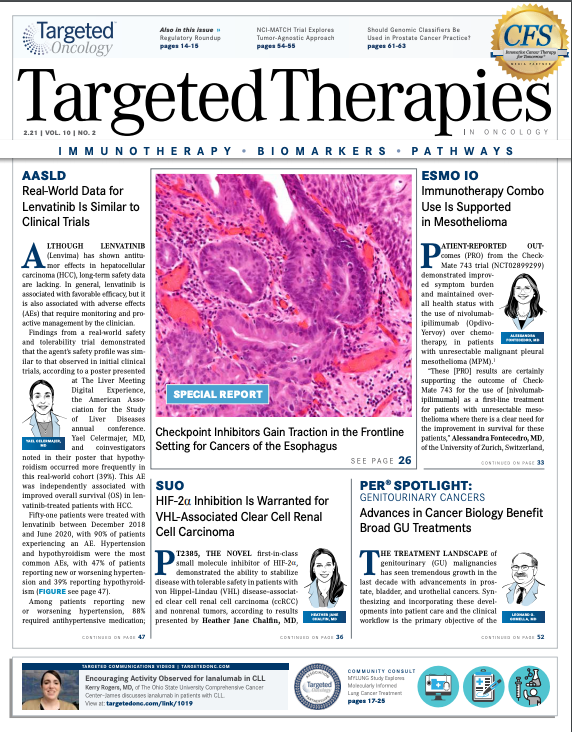Despite Limited Treatments, Advances in Frontline HCC and High-Risk RCC Heralded
Delivering the right treatment to the right patient with an eye toward tumor characteristics and gene alterations is at the heart of precision medicine. In this issue, we explore ongoing efforts to achieve precision medicine across disease settings.
Delivering the right treatment to the right patient with an eye toward tumor characteristics and gene alterations is at the heart of precision medicine. In this issue, we explore ongoing efforts to achieve precision medicine across disease settings.
The advent of immune checkpoint inhibitors (ICIs) across many cancer settings has been nothing short of remarkable, and none more so than in esophageal cancer—as detailed in the Special Report. Because of a paucity of effective treatments, results from the KEYNOTE-590 (NCT03189719) and Check-Mate 649 (NCT02872116) trials evaluating the combination of ICIs and chemotherapy in the frontline setting have given renewed hope to clinicians who treat patients with esophageal cancer (pages 26-29). In the second-line setting and beyond, findings from the KEYNOTE-181 (NCT02564263) and ATTRACTION-3 (NCT02569242) trials further established ICIs as a viable treatment in patients who are refractory or intolerant to previous chemotherapy in advanced disease.
This issue’s hepatocellular carcinoma coverage focuses on efforts to refine the use of lenvatinib (Lenvima) in this difficult-to-treat cancer. Although the agent has demonstrated antitumor effects in the second line, long-term safety data are still lacking with adverse effects that require monitoring by the treating clinician (page 47). Patients enrolled in clinical trials are different from populations treated in the real world, so efforts to delineate adverse effects are always welcome and useful to community oncologists in the clinic. In the second study presented at the American Association for the Study of Liver Diseases Annual Meeting, the use of relative dose intensity and levels of ammonia were identified as potential predictors of tolerability for lenvatinib (page 51).
The small molecule inhibitor PT2385 was evaluated in patients with von Hippel–Lindau (VHL) disease–associated clear cell renal cell carcinoma (ccRCC) and nonrenal tumors in a presentation during the Society of Urologic Oncology (SUO) Annual Meeting (pages 36-37). Disease stabilization and improvement were observed for all patients with VHL manifestations. In another study presented during the SUO meeting, nivolumab (Opdivo) given in the neoadjuvant setting demonstrated tolerability in patients with nonmetastatic, high-risk ccRCC (pages 44-45).
In the Precision Medicine in Oncology column, we turn to the NCI-MATCH trial (pages 54-55). In this umbrella trial, investigators from the ECOG-ACRIN Cancer Research Group and the National Cancer Institute sought to determine whether therapy could be better targeted if oncologists could identify molecular alterations using next-generation sequencing and administering currently available approved or experimental drugs—either singly or in combination—that fit those targets.
We look forward to sharing these advancements in precision medicine in future issues of Targeted Therapies in Oncology.

Survivorship Care Promotes Evidence-Based Approaches for Quality of Life and Beyond
March 21st 2025Frank J. Penedo, PhD, explains the challenges of survivorship care for patients with cancer and how he implements programs to support patients’ emotional, physical, and practical needs.
Read More